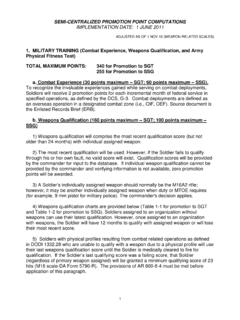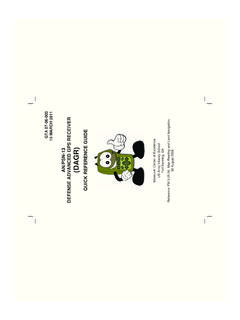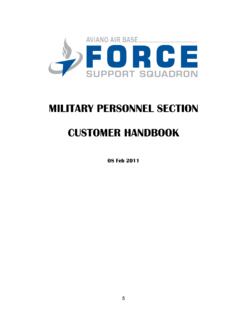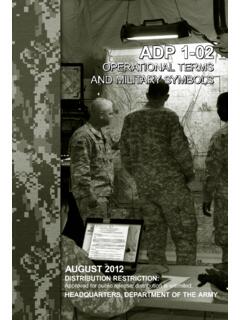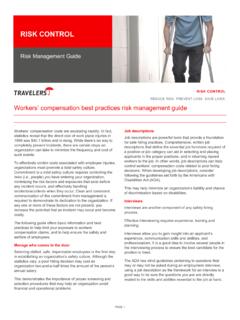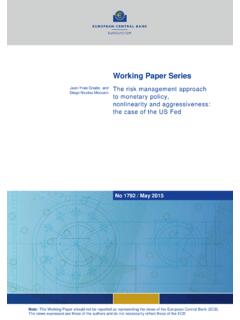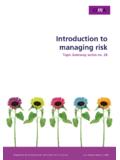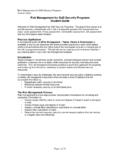Transcription of Risk Management Quick Reference Booklet - AskTOP.net
1 GTA-21-08-001. September 2014. Risk Management Quick Reference Booklet (For more detail, see ATP 5-19). The purpose of this Booklet is to provide a Quick Reference to the Risk Management (RM) process and Deliberate Risk Assessment Worksheet (DRAW). RM is the process of identifying, assessing, and controlling risks arising from operational factors and making decisions that balance risk cost with mission benefits. The Army uses risk Management (RM) to help maintain combat power while ensuring mission accomplishment in current and future operations. RM. applies to both operations and to nonoperational activities.
2 It is an essential element of the Army Operations Process, Troop Leading Procedures, Military Decision Making Process, and other organizational planning processes. Commanders, staffs, Army leaders, Soldiers, and Army civilians integrate RM into all planning, preparing, executing, and assessing of operations. Commanders ensure first-line supervisors apply the process, where it has the greatest impact. There are two recognized application levels for RM, deliberate and real-time. RM practitioners should use their best judgment to manage risk based on the situation. Approach RM at the appropriate application level, using either a deliberate approach or a real-time approach.
3 The main factor that differentiates the application level is the amount of time available for planning. Regardless of the amount of time available, Army forces manage risk throughout the operations process using the five steps of RM. Figure 1: The Risk Management Process 1. RM is a five-step cyclic process broken down into assessment and Management phases. When integrating the RM process, practitioners must keep the principles of RM in mind. This will help guide their efforts. The principles of RM. are: Integrate RM into all phases of missions and operations. Make risk decisions at the appropriate level.
4 Accept no unnecessary risk. Apply RM cyclically and continuously. DD Form 2977, Deliberate Risk Assessment Worksheet (DRAW), is the Army's standard form for deliberate risk assessment. It provides a standardized means of documenting the RM process. A copy of the RM Worksheet may be found at the back of this Booklet as well as at DRAW Heading and Preparer Instruction: Block 1. Mission/Task Description: Briefly describe the overall Mission or Task for which the deliberate risk assessment is being conducted, as well as the date(s) of the mission. Block 2. Date: (DD/MM/YYYY): The date of form preparation.
5 Block 3. Prepared By: Information provided by the individual conducting the deliberate risk assessment for the operation or training. Legend: UIC = Unit Identification Code; CIN = Course Identification Number; OPORD =. operation order; DSN = defense switched network; COMM =. commercial Block 4. Sub-task/Sub-Step of Mission/Task: Briefly describe all subtasks or substeps that warrant risk Management . If necessary, refer to SOP, Field Manuals, Soldiers Manual of Common Tasks, Job Books, etc. Step 1: Identify Hazards a. Hazards are conditions with the potential to cause personnel injury, equipment or property damage, environmental harm, or mission degradation.
6 B. Use the mission variables of METT-TC to identify hazards: 2. Figure 2: Mission Variables Mission - What hazards are unique to the mission? For example, improper material loading, and ineffective ground guide/driver communications are common hazards to rail operations. Enemy - What hazards are posed by enemy forces? Can we expect IED, small arms, mortars, RPG? Terrain and Weather - Are road conditions favorable? Are canal crossings stable? Are there dangers of personnel falling from dangerous elevations? Are there water obstacles to cross? What are the weather conditions? Will precipitation or obscuration ( blowing sand) limit visibility?
7 Is Heat or Cold injury a hazard? Are storms forecast? Troops and Equipment - Are troops adequately trained and experienced? Are they in good physical and mental condition? Are leaders competent and experienced? Is command climate healthy? Are command/control/communication systems functioning? Do we have the right equipment for the mission? Is equipment in safe operating condition? Time - Is there sufficient time to plan and prepare for the mission? Are we rushing the mission and overlooking hazards? Is there a safer time to conduct the mission? Civilian Considerations - Will the mission create unacceptable risk to civilian personnel or property?
8 Will civilians pose a hazard to the mission? What are the Rules of Engagement? NOTE: To determine the root hazard, RM practitioners consider system inadequacies in areas such as support, standards, and training, or leadership and individual failures. 3. To illustrate, tripping is not considered a hazard because another condition or circumstance caused it. To identify the root hazard, the RM practitioner must ask why a person would trip in a certain location. Repeated questioning should lead to the logical answer. The root hazard is identified once there is no longer a logical answer to the question why.
9 DRAW Instruction: Hazard: Specify hazards related to the task or subtask in Block 5. Step 2: Assess Hazards a. Consider each hazard identified in Step 1. When hazards are assessed and risk levels are assigned, the resulting analysis is a measurement of risk probability and severity of loss linked to hazards. In the context of RM, probability is the likelihood an event will occur; it is assessed as frequent, likely, occasional, seldom, or unlikely. In the context of RM, severity is the expected consequences of an event in terms of injury, property damage, or other mission-impairing factors; it is assessed as catastrophic, critical, moderate, or negligible.
10 B. Once the probability and severity levels of a hazard have been determined, use the risk matrix below to determine the initial risk level for the hazard(s). For example, if the probability of a hazard occurring is "Likely" and the severity would be "Critical", the initial risk level is "High . Figure 3: Risk Assessment Matrix DRAW Instruction: Initial Risk Level. Enter the initial risk level for each hazard in Block 6. 4. Step 3: Develop Controls and Make Risk Decisions a. Develop controls. Controls are actions taken to eliminate or reduce risk to an acceptable level. Many controls may be found in SOPs, regulations, field manuals, and operator manuals.
